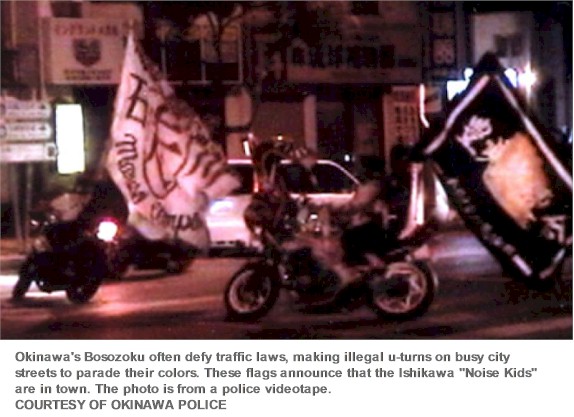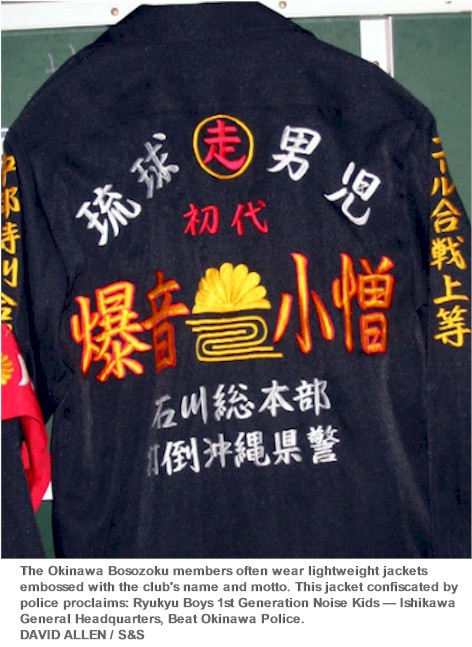
|
|
Bo̅so̅zoku
Published January 9, 2020
edited August 7, 2023
|
Bo̅so̅zoku (running-out-of-control tribe) is a Japanese youth subculture associated with customized motorcycles. The first appearance of these types of biker gangs was in the 1950s. Popularity climbed throughout the 1980s and 1990s, peaking at an estimated 42,510 members in 1982. Their numbers dropped dramatically in the 2000s with a reported number of under 7,297 members in 2012.

This isn’t Harley Davidson meets Naha. Bosozoku gangs have a history, mentality, and visual identity that is distinct. Bosozoku style traditionally involves boilersuits similar to those of manual laborers or leather military jackets with baggy pants, and tall boots. This uniform became known as the tokko-fuku (special attack clothing) and is often adorned with kanji slogans. Typical accessories to this uniform are hachimaki, surgical masks, and patches displaying the Japanese Imperial Flag. Bosozoku members are known for taking a Japanese Road Bike and adding modifications such as over-sized fairings, lifted handle bars shifted inwards, large seat backs, extravagant paint jobs, and modified mufflers. Bosozoku styles take inspiration from American choppers and greasers.
But then....
Traits and history Bosozoku are often illegal - making noise by removing the mufflers from their vehicles so that louder sound is produced. I rented a house in Konbu, Uruma, in 2017 and during the 6 weeks that I was in that village I could hear the Bosozoku Boys down the hill and across the golf course - from inside the house I could hear 'em! Bosozoku groups sometimes ride without motorcycle helmets (which in Japan is illegal), and engage in dangerous or reckless driving, such as weaving in traffic, and running red lights. Another activity is speeding in city streets, not usually for street racing but more for thrills. With many bikes involved, the front bike is driven by the leader who is responsible for the event and is not allowed to be overtaken. Japanese police call them Maru-So and occasionally dispatch police vehicles to trail the groups of bikes in an attempt to prevent possible incidents, which may include: riding very slowly through suburbs at speeds of 10-15 km/h, creating a loud disturbance while waving imperial Japanese flags, and starting fights that may include weapons (such as wooden swords, metal pipes, baseball bats and Molotov cocktails). These bosozoku gang members are generally between 16 and 19 years old. Bosozoku are often recognized as the first rung — or even a direct gateway — to the Japanese mafia. The two underground cultures have shared a longtime alliance. The stigma of their apparel is so potent that even tokko-fuku embroiderers are infected with an associative wave of taboo, and are accused of being accomplices to juvenile delinquency. In 2002, the Osaka family court authorized a request by the police to confiscate tokko-fuku worn by local bikers, claiming that the uniforms inspired “fear and reckless driving.” A former bosozoku member fought all the way to Japan’s Supreme Court to declare the ordinance unconstitutional. They were first seen in the 1950s as the Japanese automobile industry expanded rapidly. The precursors to the bosozoku were known as kaminari zoku (Thunder Tribe), Many, if not most, bosozoku members came from a lower socioeconomic class and may have used the motorcycle gang activities as a way to express disaffection and dissatisfaction with Japanese mainstream society. |
... back to the 1950s, when many veterans struggled to assimilate to new, post-war realities — like a decimated landscape and a fragile democracy. The automobile industry was particularly crippled; Toyota nearly went bankrupt as they grappled with going from war-time producer of trucks, back to consumer manufacturer.
In the 1980s and 1990s, bosozoku would often embark on massed rides, in which up to 100 bikers would cruise together slowly en masse down an expressway or major highway. The motorcyclists would run toll booths without stopping and would ignore police attempts to detain them. New Year's Eve was a popular occasion for the massed rides. The bikers would sometimes smash cars and threaten or beat up any motorists or bystanders who got in the way or expressed disapproval of the bikers' behavior. Participation in the gangs peaked at 42,510 members in 1982. In 2004, the Japanese government passed a revised road traffic law which gave the police more power to arrest bikers riding recklessly in groups. With increased arrests and prosecutions, bosozoku participation went into decline. As of 2010, police reported that the new trend among bosozoku was to ride together in much smaller groups and to ride scooters instead of heavily modified motorcycles. Aichi Prefecture was reported to have the highest number of riders, followed by Tokyo, Osaka, Ibaraki and Fukuoka. In February 2011, the Japanese National Police announced that membership in the gangs had fallen to 9,064, the lowest number since the collection of data on the gangs began in 1975. The police put the total number of gangs nationwide at 507, down 76 from 2009. Their number in the Tokyo area had fallen from 5,300 in 1980 to 119 in 2012. In 2013, the National Police Agency re-classified bosozoku biker gangs as "pseudo-yakuza" organizations. Vehicles Bosozoku are known to modify their motorcycles in peculiar and showy ways, which are called Kaizosha (modified vehicles). The general style of bosozoku bike modification appears to combine elements of an American chopper bike and a British café racer. Examples of modifications that are taken from these styles are raised handle bars like those on a chopper or over-sized fairings like those found on café racers (though bosozoku usually fit them much higher on the bike than their original position, and angled upwards at the front). A typical customized bosozoku bike starts off by taking an average 250-400cc Japanese road bike, adding a shugo exhaust system (multiple tube header), squeezing the handlebars inwards (known as shibori), and adding a 3 or 4-trumpet horn- sanren or yonren, respectively. Loud paint schemes on the fenders or the gas tanks with motifs such as flames or kamikaze-style "rising sun" designs are also quite common. The bikes will often be adorned with stickers and/or flags depicting the gang's symbol or logo. There are also marked regional differences in motorcycle modifications. For example, Ibaraki bosozoku are known to modify their motorcycles in an extensively colorful, flashy way. They will often have three or four oversized fairings in a tower-like way and an abundance of lights. Bosozoku motorcycles are often confused with Kaido Racer car modifications. In America it is common to hear Kaido Racers referred to as "Bosozoku", though this is not the case. They can often seem similar and can be seen on highways together in Japan, though they are two different things. More extreme "silhouette style" Kaido Racers often take inspiration from old race cars of the 80s. They add wide body kits and huge wings, resembling the Group 5 "Special Production Cars" of the 1970s. Stereotypes and media characterizations The tokko-fuku is usually worn open with no shirt underneath, exposing their bandaged torsos and baggy, matching pants tucked inside tall boots. "Special Attack Clothing", is the uniform of the Kamikaze pilots, the Tokko-tai (Special Attack Battalion). These tokko-fuku uniforms are typically adorned with militaristic slogans, patriotic rising sun patches, or ancient Chinese characters. The uniform is often accompanied by a tasuki, a look inspired by Japanese World War II fighter pilots. Leather jackets embroidered with club/gang logos, and even full leather suits are also seen as common elements of the bosozoku look. Other items in the bosozoku wardrobe usually include round sunglasses, wraparound headbands (hachimaki) bearing battle slogans (i.e. “police be damned” or “bring it on.”), and a pompadour hairstyle usually attributed to either the greaser/rocker look or a look that tends to be associated with yakuza thugs. The punch perm hairstyle and Surgical masks are also considered common bosozoku attire.

In Post-WW2 Europe, Italian poet Filippo Tomasso Marinetti championed the notion that, “We affirm that the world’s magnificence has been enriched by a new beauty: the beauty of speed. A racing car whose hood is adorned with great pipes is more beautiful than the Victory of Samothrace (which depicts the goddess of victory).” Perhaps the same can be said for the motorcycle. Or even a scooter!
Sources: |
©2023 Contact: ClickOkinawa.com
